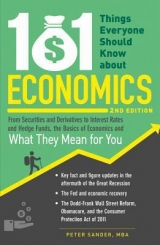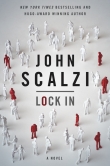
Текст книги "101 Things Everyone Should Know about Economics: From Securities and Derivatives to Interest Rates and Hedge Funds, the Basics of Economics and What They Mean for You"
Автор книги: Peter Sander
Жанры:
Экономика
,сообщить о нарушении
Текущая страница: 3 (всего у книги 14 страниц)
Taking the index apart for a moment, you can see that high inflation with low unemployment, or high unemployment with low inflation, is bad, but not as bad as things could be. The combination of high inflation and high unemployment occur in the unusual and painful combination of stagflation (see #20 Stagflation). This is the signal the misery index sends when it is at its highest.
It’s interesting to track the misery index through history, specifically through the times and policies of the various presidents. As you can see in Table 2.2, the misery index varies to a great degree during presidential terms, hitting an all-time high of 21.98 percent at one point during the Carter years as inflation hit double-digit levels at the end of his administration. This “misery” helps explain his loss to Ronald Reagan in 1980.
Table 2.2 Misery Index by President

Source: miseryindex.us
View a text version of this table
The misery index has been relatively stable since the mid-1980s, owing largely to government focus on moderating inflation rates and an absence of large oil price shocks. The sharp rise in the unemployment rate during the Great Recession drove the index over 10 during the Obama administration, but a low inflation rate has kept it from tracking higher—at least so far. The Federal Reserve has generally leaned toward controlling inflation at the expense of short-term rises in unemployment, as inflation—once imbedded in the economy—is more difficult to eliminate (see #18 Inflation). But more recently, the Fed has become more aggressive on unemployment, and has made it the target for most of its operations. The inflation rate is vulnerable but has stayed in check—in part due to moderated energy and commodity prices, and in part due to continued slack demand resulting from unemployment. The next administration may well see a misery index around 10, but with higher inflation and lower unemployment as components.
Why You Should Care
In most situations, economic policy is a tradeoff between inflation (a result of economic strength) and unemployment (a result of economic weakness). Policymakers make course corrections between the two in trying to smooth out the business cycle (see #8 Business Cycle). A high misery index indicates a loss of control—that is, some part of the policy arsenal isn’t working for one reason or another. That’s a sign of trouble ahead.
11. CONSUMER CONFIDENCE
Economists can look at actual numbers all they want, but most of those numbers simply reflect what’s already happened. Since such a large part of the economy is driven by consumer spending (see #4 Gross Domestic Product), and since economists like to see where things are going, many pay close attention to so-called consumer confidence measures. These findings follow and record how optimistic consumers are about the overall economy as well as their personal finances.
What You Should Know
Consumer confidence is a measure of perception, not actual economic activity. As a result, it can only be measured by survey—that is, by asking a carefully collected sample of people how they are feeling about their financial health and the economy overall.
There are two dominant measures of consumer confidence today: the Consumer Confidence Index (CCI) published by the nonprofit Conference Board and the University of Michigan’s Index of Consumer Sentiment (ICS). Both are revised and published monthly.
The CCI is based on a monthly survey of five thousand U.S. households. The survey, tabulated for each of the nine census regions and for the country as a whole, consists of just five questions designed to tease out consumer insights about the following:
Current business conditions
Business conditions for the next six months
Current employment conditions
Employment conditions for the next six months
Expectations of total family income for the next six months
The results are compared to similar results from 1985, considered a standard to measure against because the economy at that time was in the exact middle of a business cycle. The base is set at 100 and all other results are presented as an index versus the 1985 base. So a reading of less than 100 indicates consumer pessimism and a reading above 100 shows consumer optimism.
To put everything into perspective, at the depth of the recent recession in February 2009, CCI reported consumer confidence at 25.8; economists and the media rejoiced when it jumped to 40.8 by April of that year, still a very pessimistic figure compared to the 100 base and a reading of 144.7 in January 2000. More recently, in 2012, the index has ranged between 61.3 and 73.1; in 2013, between 58.4 and 76.2.
The ICS is similar to the CCI and asks five similar but not identical questions. The time horizon is different; respondents are asked to project economic conditions and their own finances for the next twelve months rather than six. As perhaps a truer proxy of expected behavior, they are asked about their attitude toward buying specific major household items, like automobiles.
Why You Should Care
A high CCI and ICS suggest good things ahead for the economy; a low reading reflects consumer pessimism and suggests a downturn. They are leading indicators of your own economic success. You may also want to measure your own “consumer confidence” against the readings—if you’re feeling worse about things while others are feeling better, that’s a sign that you need to consider some changes.
12. PRODUCTIVITY
Productivity is the amount of economic output, or value, derived from a unit of labor, land, or capital (the three generic forms of economic input).
What You Should Know
Productivity is a measure of economic efficiency, and especially the effectiveness of new technologies as applied to the economy. New technologies have allowed people to produce more and more, faster and faster, as anyone in today’s data– and communication-intensive world knows. But productivity increases based on technology aren’t new; the advent of railroads, electricity, and communications technologies have been revolutionizing commerce for years.
What’s most interesting is the increasing pace of technological innovation. It is still sobering to think that widespread personal computer availability and use has only occurred over the past twenty-five years; universal, browser-driven Internet use, and mobile phone use, for that matter, is less than twenty years old. It’s hard to imagine a business world without these things.
Economists study productivity in part because it’s an important factor in keeping a lid on inflation. As an economy grows, it typically adds inflationary pressure because the heightened demand for economic inputs drives prices higher. But when productivity increases—meaning more output can be generated with relatively less input—inflationary pressure is reduced. That fundamental was closely watched during the Federal Reserve’s Greenspan years, as the Fed could stimulate the economy with low interest rates without necessarily triggering inflation. Increased productivity, due mainly to advancements in technology, was one of the reasons.
Incidentally, that gain in productivity didn’t happen right away. For many years, economists recognized a productivity paradox, where the advent of technology tools did not necessarily spur productivity. This was the case in the late 1980s and early 1990s. In fact, some thought this new technology, especially computers, hurt productivity, since more resources were expended implementing the technology than producing output. Computer technology also increased the size of firms and bureaucracy, making both less manageable. The reality was that business hadn’t learned to use the machines effectively at that point. However that’s no longer the case, as U.S. productivity has been improving for years (though the rate of improvement has slowed in recent years). That, in fact, is one reason employment hasn’t responded as well to economic stimulus as policymakers might have hoped—companies have figured out how to produce more stuff without hiring more people.
Why You Should Care
Everyone should strive for greater productivity. As the economy becomes more productive, the onus is on you to become more productive personally too—otherwise you’re losing ground! When new technologies become available, it doesn’t mean you have to use them, but you should at least familiarize yourself with them. Imagine where you would be if you refused to use PCs, e-mail, and mobile phones!
At the same time, if U.S. economic productivity went into a decline, that would be a bad sign for both economic growth and inflation. More resources would be consumed to produce the same amount of output, which would likely result in higher inflation, shortages, poor profit performance on the part of firms, and, ultimately, higher unemployment. With productivity, “turning back the clock” is a bad idea.
13. ECONOMIC INDICATORS
Economists love to measure things and are always looking for ways to gauge future economic trends. They have developed a set of leading economic indicators, measures of the economy designed to help us figure out “where the puck is going,” as hockey great Wayne Gretzky would have put it. Economists also track a set of lagging economic indicators to measure where the economy has been, diagnose change, learn from it, and make better predictions for the future.
What You Should Know
Like the CCI, the Conference Board has put together a monthly index that combines ten different leading indicators, not surprisingly referred to as the Conference Board Leading Economic Index (LEI). Without going into details (although some are covered in this book), here are the ten leading indicators:
Stock prices
Index of consumer expectations
Manufacturers’ new orders for consumer goods
Manufacturers’ new orders for nondefense capital goods
Average weekly manufacturing hours
Interest rate spreads
Index of supplier deliveries
Initial claims for unemployment insurance
Money supply
Building permits
There are seven lagging indicators in the Conference Board Lagging Economic Index (LAG):
Ratio of consumer installment credit to personal income
Commercial and industrial loans outstanding
Average duration of unemployment
Change in labor cost per unit of output
Change in prices (Consumer Price Index) for services
Ratio of manufacturing to trade inventories
Average prime rate charged by banks
So any economic measure must be either leading or lagging, right? No, nothing is ever quite so simple. Some indicators are considered to be right in the middle, or coincident indicators. The Conference Board tracks four of these in its Coincident Economic Index (CEI):
Personal income minus transfer payments (like Social Security)
Manufacturing and trade sales
Nonagricultural employees on payrolls
Industrial production
Why You Should Care
You may want to keep track of these indexes and the general movement of indicators, especially leading economic indicators. It is possible to track some of the leading indicators yourself, like the stock market and Consumer Confidence indexes, before seeing them compiled into this “big picture.” Investors, in particular, find the LEI/CEI/LAG indexes to come late in the reporting cycle, too late to buy or sell on the news. But to get the big picture, and to understand the news as it comes at you, these measures can be helpful.
14. DISTRIBUTION OF INCOME AND WEALTH
If everything were perfect in today’s economy, it would perform in line with a slogan rooted, ironically, in Socialist ideals: “From each according to his abilities; to each according to his needs.” That is to say, in this perfect world, income and wealth distribution are natural and track economic contributions exactly. You work and you’re paid the exact value of what you produce, and so is everyone else. You reap what you sow. You spend what you earn, or preferably a little less, as you save for the future. Your investments grow exactly in line with the economy. The economy grows, you grow, and everyone prospers.
Unfortunately, it doesn’t work that way. While the United States and many Western economies are capitalistic and free and the so-called “invisible hand” doles out benefits largely commensurate with contributions, the largest income and greatest wealth don’t always accrue to those who produce the most.
What You Should Know
Economists concern themselves with the inequality of income and wealth distribution. In terms of household income, the U.S. median in 2009 was $47,637, meaning that 50 percent of all households earned more, 50 percent earned less. The 20th percentile level was $20,453, while the 80th percentile and 95th percentile were $100,000 and $180,001 respectively. That’s a large gap, and that gap has been growing in recent years. Between 1980 and 2009, the gain in income for the top 5 percent of Americans was 43 percent, or 4.3 times the 10 percent gain experienced by the lowest 20th percentile over the same period. Since the income base at the high levels is larger, the disproportionate size in percentage gains is even more significant. While some of this is explained by the growth in double-income households, one basic fact cannot be denied: the wealthy are getting wealthier, while the poor are getting poorer.
However, there is a difference between income and wealth.
In financial terms, wealth is the items of value a person owns, whereas income is the economic value a person receives as a result of work or investing, but does not necessarily retain. It’s helpful to remember that income is a cause; wealth is an effect.
So some economists also focus on the distribution of wealth. As a matter of brevity, rather than sharing wealth statistics, I direct you to the fascinating study done by the U.S. Federal Reserve every three years known as the Survey of Consumer Finances. This survey not only points out the characteristics of wealth distribution and asset ownership, it also provides a fabulous benchmark for you to see where you stack up against other citizens. You can view the survey at www.federalreserve.gov/pubs/oss/oss2/scfindex.html.
Finally, it is sobering to examine worldwide data on this subject. According to statistics published by the United Nations University World Institute for Development Economics Research (UNU-WIDER) back in 2006 but still quite relevant:
North America represents 5.2 percent of the world’s population and 34.4 percent of the world’s net worth
Europe represents 9.6 percent of the population and 29.2 percent of the net worth
Asia represents 52.2 percent of the population and 25.6 percent of the net worth
Africa represents 10.7 percent of the population and 0.54 percent of the net worth
Why You Should Care
The distribution of wealth and income at a national level are interesting topics, especially for policymakers and social scientists. Efforts to redistribute wealth, for good or bad, become part of tax policy.
For individuals, it’s important to know where you stand and to make sure your income—cause—is creating some wealth for you—effect. It’s also important to make sure what you’re calling “wealth” is truly wealth—not a fiction in a pretty wrapper known as the “wealth effect” (see #15 The Wealth Effect). Finally, it’s good to appreciate the advantages you have compared to others in the United States and the world. As stressful and depressing as things seem at a given point in time, understanding income and wealth distribution on the U.S. and worldwide stages will make you realize how much better off you really are.
15. THE WEALTH EFFECT
Have a lot of dough in the bank? Stocks been doing well? House has gone up (or recovered) $100,000 in value in the last two years? You might feel like spending money even if your income hasn’t gone up a bit. Why? Because of the wealth effect.
What You Should Know
Wealth effects can happen when people actually are richer (when their incomes rise) or when people feel richer—as they did in a big way twice this past decade—because of the increase in the value of stocks, real estate, or other assets. The latter effect is dangerous because asset prices don’t always match asset values, and things can change quickly.
The wealth effect created in the 2005–2007 real estate boom became doubly dangerous as people not only felt wealthier but used that wealth—their home values—to borrow money to buy things they couldn’t otherwise afford. They used their homes as ATM machines. When prices came back to earth, not only were these unfortunate citizens less wealthy, they also had a lot of new debts to pay. The subsequent deleveraging (see #9 Deleveraging) caused a steep drop in economic activity and a vicious circle of unemployment, falling asset values, and still more unserviceable debt we all became familiar with.
Two scenarios can get people to spend more: (1) They are actually richer, be it through a raise, bonus, or some other form of increased income; (2) They perceive themselves to be richer, for example with an increase in their portfolio or assessed home value.
Interestingly, the wealth effect can turn on a dime. A January 2008 Gallup Poll reported that 56 percent of Americans thought their standard of living was getting better, while only 26 percent thought it was getting worse. By February 2009, those figures had reversed: 33 percent of Americans thought their standard of living was getting better while 44 percent thought it was getting worse. As we emerged from the Great Recession, people became once again more optimistic, and a resurgence in the stock markets has helped make people more comfortable with their finances—but it didn’t cause a huge boom. As economist Robert Samuelson put it: “Careless optimism has given way to stubborn cautiousness.”
Why You Should Care.
For starters, never equate the accumulation of “stuff” with being rich, and never count your asset chickens—particularly noncash assets—before they’re hatched. You should never expand your lifestyle based on such asset values, but rather income and real worth after current and future obligations (like a college education or retirement) are met. Once people attain a standard of living they cannot afford, it is devilishly difficult to go back. The tendency is to expand further, borrow more, and become even more vulnerable.
Don’t let the wealth effect make you overconfident, complacent, or even arrogant. When you feel you can afford anything without really running the numbers, that’s either a sign that you’re really rich or that you’re a victim of the wealth effect. When that happens tap the brakes and retreat to the basic lifestyle truly congruent with your real income and wealth. Someday you’ll be glad you did.
CHAPTER 3
Money, Prices, and Interest Rates
What would an economy be without money? For that matter, how would life work without money? Sure, you could exchange an hour on your job directly for a package of T-bone steaks, a sack of potatoes, and a bottle of wine, but how complicated would that be? Especially when your cube buddy wants the makings for a Caesar salad instead. And what would happen if you needed to go to the doctor, and all you had to pay with was your steak and potatoes?
Yes, money simplifies the economic picture by giving us a standard of exchange. Money is simply a commodity that can be universally exchanged as “legal tender” for all other commodities and services. It is the lifeblood of an economy. Yes, it does make the world go round.
Like any other commodity, there can be too much of it or too little, and its true worth is judged only by the value of other commodities. So like the economy it supports, the value and worth of money can change over time. Those changes become apparent as changes in prices. Furthermore, unlike most other commodities, money can be used as a lever or tool to moderate, manage, or control the economy. Economists and policymakers concern themselves with the worth of money, the cost of money, and the use of money to influence the economy. This chapter covers money and its interaction with the economy.
16. MONEY
You probably wouldn’t be reading this book if you weren’t interested in money—or at least, the necessities and pleasures that money buys.
What You Should Know
Technically speaking, money is anything that is generally accepted as payment for goods and services and repayment of debts. Usually, it comes in the form of paper or coins, but anything could be used as tender, even bottle caps, if society set an accepted standard for using bottle caps as payment. Money is used primarily as a medium of exchange, but also as a unit of measure of financial activity and as a store of value.
As a medium of exchange, money works because of its universal acceptance. If you try to pay for a cartful of groceries with a goat, it might work, but only if the grocer happens to need or want a goat. Money is designed to work for everybody, no matter what they need or want to purchase. It is much more efficient than direct barter. Although “plastic”—credit and debit cards—has seemingly replaced money, it isn’t really money, only a convenient way to administer the payment; the real money changes hands later on behind the scenes.
As a unit of measure, or “unit of account,” as economists call it, money is a handy means to place a value on things. A tab for $104 worth of groceries is much easier to comprehend than a tab for 2⅔ goats. Likewise, imagine the difficulties measuring GDP, incomes, and so forth without money. Finally, money is divisible into known and like units; if one were trading in diamonds instead, no two diamonds are worth the exact same amount, and would thus complicate the exchange.
The money we see comes in the form of currency—that is, printed paper and minted coinage representing units of generally accepted value. As a store of value, one can convert anything to money, at least for the short term, and store the value there until something else is purchased. Many economists caution against relying on money as a store of value for too long, as the increase in money supply (see #17 Money Supply) over time makes a unit of money worth relatively less. Some question whether current economic policies in the United States, Japan, and other countries will drive the value of money down and threaten its status as a store of value.
The vast majority of money doesn’t exist as $20, $10, $5, and $1 bills, but rather as deposits in banks. Those sums of money—and almost everyone has some—can be created by credit and moved around with a check (the old way) or the click of a mouse or keyboard.
Finally, U.S. money is a type of money known as fiat money, meaning that its value, and that it be accepted as a means of payment, is determined by government order. It is not backed by any hard asset such as gold. Technically, you can only exchange a U.S. dollar with the U.S. government for another dollar. Until the 1960s, that wasn’t true—you could exchange currency for gold or silver, depending on the type of money you held.
Why You Should Care
It’s always useful to step back and think about what money really is. It isn’t an end in and of itself; it is a unit of exchange. It can be exchanged for something else later on. Understanding what money is and what it’s for can give you a more balanced perspective for managing your finances.
17. MONEY SUPPLY
Money is a commodity, just like any other commodity you might purchase with it. The money supply is the amount of money within an economy available for purchasing goods or services. The central banks—in the United States, the Federal Reserve—keep close tabs on the money supply, as the amount of money in circulation can have a big effect on the economy (see #30 Federal Reserve, #29 Central Bank, and #18 Inflation).
What You Should Know
Money is created by either printing paper tender or by making it available as credit through lending. When the central bank lowers interest rates, it stimulates the creation of more money through lending. When there is more money in circulation, people have more money and spend more money, stimulating demand for goods and services. That helps businesses and creates a stronger economy, but also threatens inflation, since more money is chasing the same amount of goods and services, making the money worth relatively less.
The Federal Reserve measures several categories of money supply, four of which are more mainstream and likely to be in the news. The M0 figure is so-called base money—currency (bills and coins) and central bank deposits. The M1 figure includes so-called demand deposits, roughly equivalent to amounts in checking accounts—money on hand as a deposit in an institution designed to be used actively to buy and sell goods and services in the short term. The M1 is the most “spendable” money in circulation at a given point in time. The M2 adds money in time deposits like savings accounts and CDs—money that is there but not as likely to be used actively for transactions. And M3 adds large time deposits like repurchase agreements and institutional money market accounts—also long-term in nature, and largely out of consumer hands. Economists tie their horse to M1 in terms of measuring the amount of money really flowing around and through the economy; it is like “working capital” in a business.
Why You Should Care
Economists watch money supply to forecast inflation and other economic effects. If you see reports of increasing money supply, it can mean good times ahead, but it can also mean inflation. Be suspicious of prolonged money supply increases—the government and particularly the Fed may be sacrificing the future by driving down the value of money in an attempt to realize a short-term gain in business activity and employment.
18. INFLATION
Inflation is an across-the-board rise in prices of goods and services over a period of time. When inflation is present, the purchasing power of a given unit of money buys fewer goods and services; that is, the “real” value of money is less. The idea of inflation is generally scary, as nobody wants to see the decline in the value of money. But if kept in check, some inflation is actually okay, and may even be beneficial.
What You Should Know
Inflation is generally measured by two indexes tracked as “basket of goods” proxies of overall price activity, the Consumer Price Index (CPI) and the Producer Price Index (PPI). The Department of Labor’s Bureau of Labor Statistics publishes both figures, along with a core CPI figure that strips out the “more volatile” food and energy components. Since we all need food and energy, some choose to ignore the “core” figure.
Inflation can be caused by changes in demand, supply, or a combination of the two. Demand-based, or demand-pull, inflation occurs when people have too much money or too much cheap money (that is, easy credit), and it chases a fixed level of goods and services. The antidote is to make money more expensive by raising interest rates or decreasing the amount of money available, both normally well in the control of the central bank, in our case the Federal Reserve. Inflation can also be caused by shortages of a commodity, like oil, where price spikes will eventually trickle into the entire economy. Or they can be a combination of the two, as seen in early 2008 when both a supply shortage and a demand increase driven mostly by China drove energy prices higher with a fairly rapid trickling through the economy.
Depending on the amount and consistency of inflation, it can have positive or negative effects on the economy. Too much inflation discourages saving, as the purchasing power of that saving will deteriorate. High inflation may create shortages as people “stock up” in anticipation of rising prices. It creates fear and uncertainty in the business world, delaying business investment, because no one can predict what raw materials, labor, and other “inputs” will cost in the future.
Modest inflation—in the 2 to 4 percent per-year range—is seen as a good thing. Why? Because it’s better than the opposite: deflation (see #19 Deflation). Moderate and predictable inflation is thought to help avoid recessions and sharper business cycle reversals. Inflation also helps borrowers, for the dollars they will use to pay back debts will be worth less in the future, thus easier to come by, as most debts do not get larger with inflation.
It’s interesting to note that inflation and deflation once occurred in sharp and unpredictable cycles. More recently, central bank intervention has moderated those cycles, and has avoided deflation altogether, at least in the United States, since the Great Depression. The moderate and steady inflation rates enjoyed particularly since the oil shocks of the 1970s have created a favorable business climate. See Figure 3.1 for a long history of inflation rates. (It should be noted that this chart is the same as presented in the first edition and only takes us through 2006, but the 356 years before that remain instructive)
Figure 3.1 U.S. Historical Inflation Rate

Source: Wikipedia
Data Source: John J. McCusker, How Much Is That in Real Money?: A Historical Commodity Price Index for Use as a Deflator of Money Values in the Economy of the United States, American Antiquarian Society, 2001; Consumer Price Index (from 2001 forward)
Why You Should Care
Inflation can be one of the biggest enemies to your finances and financial plans, particularly if you save money. Those savings will be worth less over time if the rate of inflation exceeds the interest rate your savings earn. Most recently, wage increases have not kept up with inflation, another cause for concern. Hard assets like gold and real estate are thought to hold up better in inflationary times, but obviously real estate is no longer as safe a haven as once thought. These days, people have learned to fight inflation by consuming less or buying less expensive goods and services, but that isn’t a strategy for the long term. Inflation remains a persistent threat to finances for all of us, especially as central banks “fix” economic problems by increasing credit and the money supply. Although inflation hasn’t been a big news headline lately, it’s important to watch inflation closely—particularly in the things you tend buy a lot of, including food, health care, and energy.






![Книга Make Winning a Habit [с таблицами] автора Rick Page](http://itexts.net/files/books/110/no-cover.jpg)
